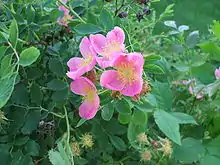| Rosa arkansana | |
|---|---|
 | |
| Scientific classification | |
| Kingdom: | Plantae |
| Clade: | Tracheophytes |
| Clade: | Angiosperms |
| Clade: | Eudicots |
| Clade: | Rosids |
| Order: | Rosales |
| Family: | Rosaceae |
| Genus: | Rosa |
| Species: | R. arkansana |
| Binomial name | |
| Rosa arkansana | |
| Synonyms | |
| |
Rosa arkansana, the prairie rose[1] or wild prairie rose, is a species of rose native to a large area of central North America, between the Appalachian and Rocky Mountains from Alberta, Manitoba, and Saskatchewan south to New Mexico, Texas and Indiana. There are two varieties:
- Rosa arkansana var. arkansana
- Rosa arkansana var. suffulta (Greene) Cockerell
The name Rosa arkansana comes from the Arkansas River in Colorado. The species' wide distribution and consequent genetic drift has led to an extensive synonymy. It is a perennial subshrub and its native habitats include prairies, roadsides, and ditches. The plant attracts butterflies and birds.[2]
The name prairie rose is also sometimes applied to Rosa blanda, also known as the meadow rose or smooth rose, which is also widely spread, but somewhat further to the north.
Symbolism
Wild rose is the state flower of the U.S. states of Iowa and North Dakota. In Iowa, convention states the species is Rosa pratincola (currently treated as a synonym of Rosa arkansana). North Dakota, on the other hand, specifies either Rosa arkansana or Rosa blanda. Alberta's "wild rose" is Rosa acicularis.
Cultivation
Rosa arkansana is grown as an ornamental plant, and has become naturalized in parts of Massachusetts, New York, and North Dakota.
References
- ↑ USDA, NRCS (n.d.). "Rosa arkansana". The PLANTS Database (plants.usda.gov). Greensboro, North Carolina: National Plant Data Team. Retrieved 23 October 2015.
- ↑ "Lady Bird Johnson Wildflower Center - The University of Texas at Austin". www.wildflower.org. Retrieved 2022-01-02.